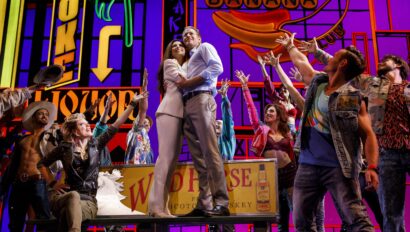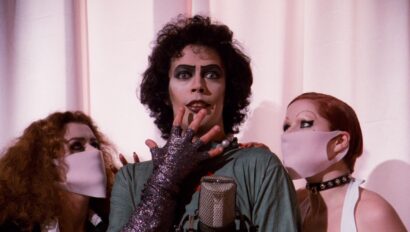Behind the Scenes with Eduardo Vilaro from Ballet Hispánico
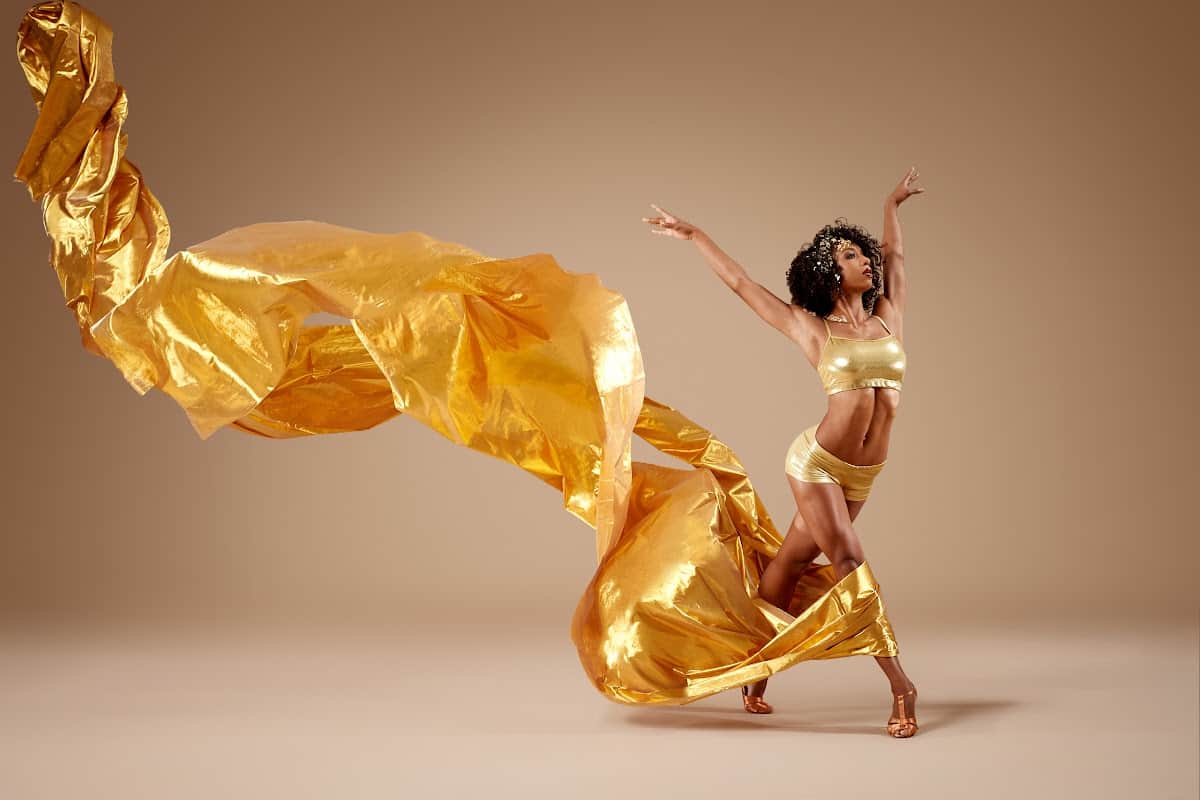
Lisa Condit spoke with Eduardo Vilaro from Ballet Hispánico about the his career, the history of Ballet Hispánico, the inspiration behind performances and so much more. Read on for highlights from the interview, or listen to the full interview below. Tune in to Talk of the Commonwealth with Hank Stolz on WCRN 830AM Fridays at 9 AM and Saturdays at 1 PM for more behind-the-scenes interviews.
Lisa: Thank you all for listening to Behind the Scenes at The Hanover Theatre. This is Lisa Condit and I’m so pleased to bring you Eduardo Vilaro. He is the Artistic Director and CEO of Ballet Hispánico, which has been the leading voice intersecting artistic excellence and advocacy. It is now the largest Latinx cultural organization in the United States and one of America’s cultural treasures. Welcome!
Eduardo: Thank you so much. I’m so excited to be here with you today.
Lisa: It’s my pleasure, believe me! I’m so looking forward to when Ballet Hispánico graces our stage on Friday, April 22. For all of you listening, this is in partnership with Music Worcester and curtain time is at 8 PM. Eduardo, tell us tell us a little bit more about your journey here and Ballet Hispánico. I know that there are many people who are listening who aren’t familiar with Ballet Hispánico, and they should be.
Eduardo: Ballet Hispánico, first off, was founded by Tina Ramirez, an educator and flamenco dancer that wanted to give voice to the Latinx artists, or to the Hispanic artists as we were called at that time. It was a very ground roots operation. She started training and teaching flamenco and other forms to a handful of young dancers and they got so good that they started performing carnivals, festivals and smaller theaters. From 1970 to now, as you said, it is America’s largest Latino and Latina dance organization. I want to be clear for your listeners; it is not a folkloric company although it sounds like it, right? Ballet Hispánico. Even for me, it brings up beautiful skirts and colors.
Ballet Hispánico is a contemporary ballet company that takes our tradition from the over 21 Latinx dance nations, and fuses it with contemporary modern jazz and all kinds of forms in order to express what today’s Latinx person is here in America.
Eduardo Vilaro
Eduardo: As immigrants, we come, we fuse and we become something else – we become American. I think that that is the difference between a folkloric company and who we are. I’m so excited to share it with your audiences. This will be the first time we’re in Worcester, and I’m just beyond thrilled.
Lisa: We are also thrilled. We’re thrilled to see the Latinx population right there on our stage and doing these interesting… I don’t want to call them numbers because that’s probably the wrong word. How would you describe how your program is going to be divided and what our audiences can expect?
Eduardo: Yeah, I love that you started with “I don’t want to call it that.” For me, I like to say that they are expression – these works, these ballets. You can also call them a ballet or expression from the minds of these choreographers. We’re closing on our 50th anniversary, so you’re getting this fantastic evening called “Nocho de Oro,” or a golden evening. It is a little trajectory from the beginning, something from the 70s and 80s, all the way to now. We start off the evening with “Arabreqsue” by Vicente Nebrada. Vicente Nebrada was a Venezuelan choreographer who was creating work back in the 60s and 70s. He was one of the few unsung heroes of our Latinx dance choreographers. I wanted to make sure that we honored him and uplifted his voice at a time when we’re now asking for different narratives in all our entertainment and media. So, we start with this piece called “Arabesque”, and “Arabesque”, of course, while it is a French word, it is a word that is fused with so many different cultures. The Arabesques that you find in the Moorish artistic view, the Arabesque that is in the line of the dancer and in the work, all of that comes together in this beautiful group or that is about fusing flamenco and the ballet idiom.
Lisa: I love it.
Eduardo: It’s gorgeous. The music is by Enrique Granados. It’s all piano music and it is stunning.
Lisa: I believe it, I can’t wait to see this. We start with “Arabesque,” and then take us on a little journey because you said it’s over the 50 years. Take a little descriptive journey, if you don’t mind.
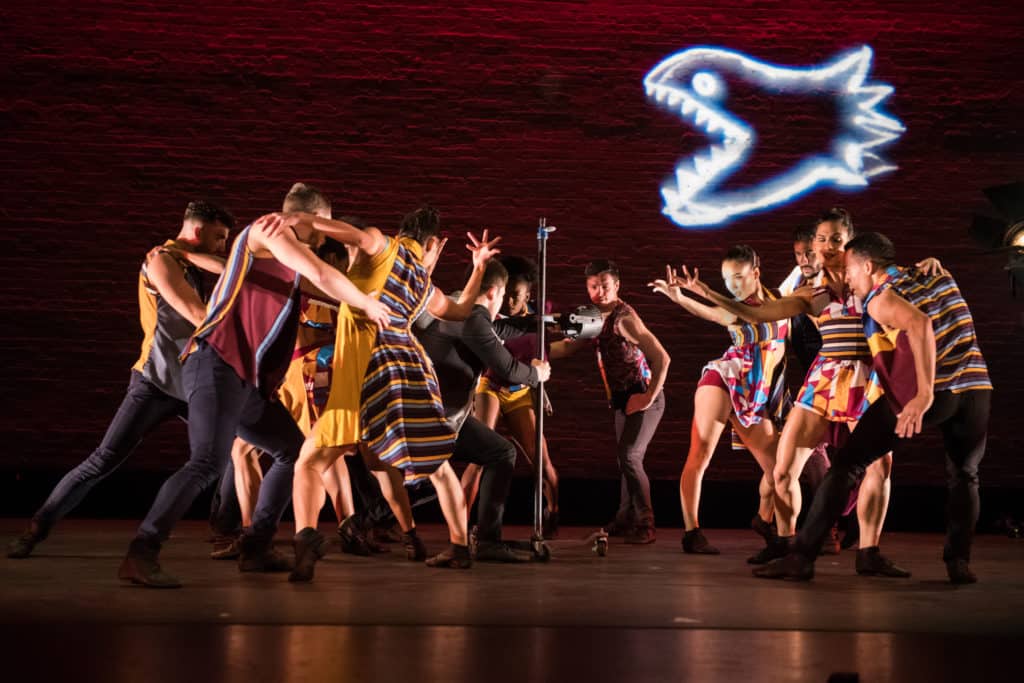
Eduardo: Sure! We move on after a pause, we move on to “Tiburones”, which means “sharks.” “Tiburones” is kind of like our middle piece because it was done quite a few years ago right before the pandemic. “Tiburones” means “sharks” in Spanish, and when you say “sharks,” for me, as a person in the arts, you think West Side Story, and that’s exactly right. The choreographer Annabelle Lopez Ochoa and I were sitting having coffee one day, and we were mentioning how interesting it is that there’s this resurgence of interest in West Side Story all over again. West Side Story is a beautiful musical, one of my favorites, but has a lot of baggage for our community because it left a lot of stereotypes. It was interesting for us to see why this was coming back at this point, and why weren’t any of the creators Hispanic or Latinx? It was really a shock to us at a time when we have this social conversation happening. I said, “Well, we have to do something about it.” She said, “Let’s make a dance,” and I said, “Let’s make a dance. That’s what we do.” We talked about it and she created this piece that is about the days. Who’s looking at culture? In her piece, it’s the media and the creators of media. I’m just going to leave it there because it is both poignant and fun and very theatrical.
Lisa: Again, I can’t wait! This sounds very exciting to me. For our listeners and those who know me, I am a little bit of a dance geek so it’s not a surprise for anybody that I’m so enthusiastic about this. I love that your philosophy is also based on the belief and the power of the arts to change lives, reflect and impact culture and strengthen community – so true! Are there any other pieces or ballets that you’ll be presenting that really speak to that or your favorites that you want people to really keep in mind as they’re watching your performances?
Eduardo: I think they all do speak to that. I’ll talk about the last work; the last work is just a celebratory work by Gustavo Ramírez Sansano, a Valencian choreographer who took the music of Pérez Prado and that 50s lounge sound, and decided to create a work that plays with the music and plays with icons. This is about really juxtaposing music with what you hear, what you think might be the dance and something completely different. He’s a very athletic and contemporary voice in the dance world today. It is fun, it is fantastic and a great way to end the evening. When you think of all these works together, thinking about fusion, thinking about the gays with “Tiburones,” stereotypes and then thinking about how we celebrate and how we feel we look like. That is how you change. I love that when an audience comes and questions and says, “Oh, is that Hispanic? Was that Latinx?” Yes, it is and so much more.
This is an expression from an authentic voice, a Latina or Latino who is experiencing their art form in the world today, and that’s how change is made. Not by just placing stereotypes or icons, but moving the discussion. The beautiful thing about dance is that it allows us to appreciate an expression in a form that is sometimes very foreign to us.
Eduardo Vilaro
Eduardo: It’s movement, it’s the corporal language. It makes us really sit and watch and say, “What is being said to me at this time?” Like a good painting, like a Rauschenberg or a Caravaggio, “What is being said?” My hope is that the audience leaves having a conversation with each other about it.
Lisa: I am 100% positive we will. Everybody, join us April 22 at 8 PM. Tickets are still available on our website, TheHanoverTheatre.org. Tickets start at just $39 and student tickets are $25, so this is very affordable and accessible. I also wanted to ask you a little bit about your background and what brought you here. I saw from your bio that you were born in Cuba and then raised in New York. It sounds like you moved here when you were about six years old, which must have been quite the experience. How did you get into dance and ballet? Tell us more about that!
Eduardo: It’s a very interesting kind of Billy Elliot story. I was in the Bronx, trying to learn a language, trying to fit in and trying to feel like I belonged and connect. Here’s a shout out to teachers and arts education for our world. It wasn’t until we had a substitute teacher at a small parochial school; a substitute teacher, who was an actor and a director, took over our class and he said, “We’re going to do a musical and it’s great.” I auditioned for it and I received the part of Linus, who has to dance with a blanket. The teacher said, “I don’t dance, so you’re going to have to figure this out,” so I created. The conversation that I was talking to you earlier about the arts, that connection really changed me. From then on, it was all about discovering dance, who I was and trying to find my voice, trying to find my voice and assimilate. Right now, we call it acclimating, but back then, you had to assimilate. We were not allowed to speak Spanish in the streets, only at home. It was a beautiful time for me because even through high school, I searched for it. I started taking Capoeira, which is a dance martial arts form and next door, there was a ballet class. I would sneak into the ballet class, even though I told my family that I was going to this martial arts class.
Lisa: I’m just picturing this!
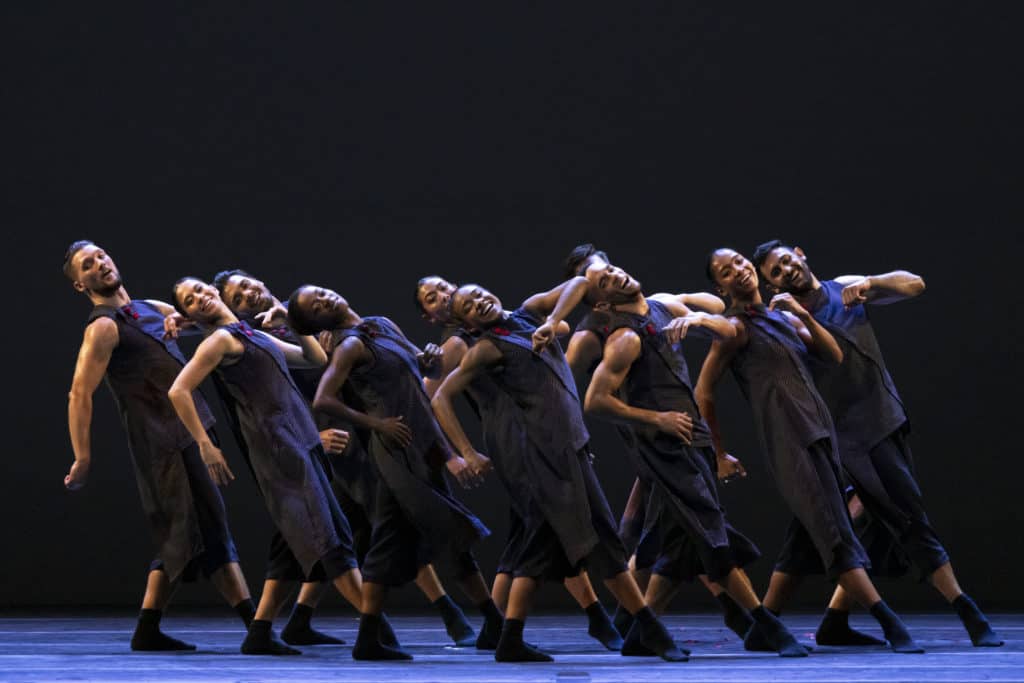
Eduardo: I would be hiding in tights and ballet slippers. The Bronx was tough at that time and if anyone knew or thought that you weren’t your very “macho-est,” it was difficult. It was difficult and there was a lot of bullying. But, I just had a vision of this art form and what it meant to me and to my culture. I auditioned one day for a program at Alvin Ailey Summer Program and was accepted and I worked at Martha Graham and trained there. It just built and built, and then I was accepted into a dance program at Adelphi University. I was the first one of my family ever to have a higher education. I went and got a higher education and got to dance. Then, I found Ballet Hispánico and it’s history from then on. I’ve had an over 30 years relationship. I was a dancer for a decade there, then I moved to Chicago because I wanted to get a Master’s Degree. Once I did, I said, “Dance is still the thing for me.” So, I started my own organization in Chicago with a dance company as well, that did extremely well. It did so well that Ballet Hispánico, when my mentor and our founder decided to step down, she said, “I think Eduardo is your guy.” During the third stage, they called me and I went, and the rest is history. I’ve been the Artistic Director now for 14 years.
Lisa: That is fantastic and what an inspirational story.
Eduardo: Sorry if I went on too long.
Lisa: No, not at all. We definitely want to hear your story. What you have to say is so important for other people to hear, regardless of color. I think that everybody experiences that bullying if they’re a little bit different than their peers, especially in that elementary, junior high and off in the arts, dance for you and dance for me as well, in complete transparency. It offers a place where people can succeed and gain that self-confidence, and gain some of those other skills that help all of us succeed and be able to communicate with each other. The form of expression is so important to everybody’s mental health, which is a very important topic in today’s world. I love hearing your story, Eduardo, and I’m sure our listeners do as well. Our students at the Conservatory, I am 100% sure will tune in to hear what you say. We have a very strong ballet program, so is there anything you would like to tell them? We have students from every age bracket.
Eduardo: Yes! I think this is really important to hear because I can tell you that you have to be dedicated and you have to do work. What I’m going to say is, don’t let anyone ever tell you that you can’t do it, because I was one of those kids. I was told by a professor while I was training, “You will never amount to being a dancer.”
Lisa: Unbelievable.
Eduardo: Because there’s always someone who sees their form in their way. I just want to tell the students that you have your own vision.
Nurture a vision of yourself being in the arts, being a dancer and go for it. Don’t let anyone ever say that you can’t, because you can.
Eduardo Vilaro
Lisa: For sure. Let your light shine, right? The other thing is, ballet is the basis. Once you can master ballet, it helps you in every other dance form. I’ll share with you that I was a dance major at one time at UMass Amherst. The dean of the department at that time, and this was in the height of Mikhail Baryshnikov, told me that ballet was a dying art form and going away, which is ridiculous. I did drop out of that program for a couple of different reasons. Amen for showing that person that ballet is not dying at all. In fact, I feel like it’s made a resurgence and I feel like there’s a lot more respect for the athleticism, as well as the artistry that goes into making a truly great ballet dancer. It is the basis for all other dance forms. If you can do what the ballet dancers can do, then everything else is pretty much a piece of cake.
Eduardo: I agree. I think you know, when I hire dancers, I look for a dancer with lots of personality that shines through that fourth wall that we know so well. The next thing I look for is an understanding of how their body can utilize the ballet technique in order to be a palette for any choreographer.
Lisa: Absolutely. For everybody listening, we’re speaking with Eduardo Vilaro. He is the Artistic Director and CEO of Ballet Hispánico. They are bringing their wonderful evening “Nocho de Oro”, the 50th anniversary program to our stage Friday, April 22. We do have some really reasonably priced tickets, starting with student tickets at $25 and adults start at $39, available at TheHanoverTheatre.org or by contacting our box office at 877.571.SHOW (7469). We certainly hope to see you there. Eduardo, anything else you’d like to tell our listeners before we have to say goodbye?
Eduardo: No, I just am so excited to be there. I welcome you and invite you to come and enjoy this work. If you see me, stop me and let me know what you think.
Lisa: Thank you so much, Eduardo. We are looking forward to having you. Thank you everybody for listening, and we’ll talk to you next week on Behind the Scenes at The Hanover Theatre.
